How To Take away Background Noise, Distortion in Audacity
It’s useful to have some devices and experience to wash up a loud audio file. Perhaps when digitizing an outdated and treasured family tape recording or when you can have captured that unbelievable interview in your podcast nonetheless there’s an annoying background noise.
Whilst you might’t make each half good there are numerous approaches to enhancing an audio file and, considerably excellently, numerous these devices are found already constructed into the free and open provide audio editor Audacity.
Audacity could be utilized as an audio recorder with numerous microphones, or it could nicely work with present audio info (WAV, MP3, OGG, AIFF and so forth). For this how-to we’ll work on some pre-recorded audio that requires cleaning up.
Placing in Audacity
1. Receive and arrange Audacity in your working system.
2. Click on on File >> import to herald your objective audio file.Audacity fortuitously handles many audio file kinds, the widespread uncompressed WAV and AIFF info, the equally widespread compressed MP3 info, however as well as barely a lot much less widespread kinds akin to OGG and FLAC info.
3. Click on on the play button to take heed to your file. The waveform represents your audio file. A single waveform signifies a mono recording, two waveforms symbolize a stereo audio file (left and correct channels.
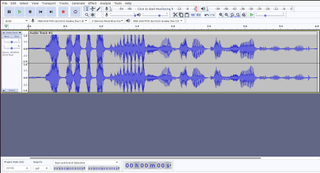
Determining the issues
When trying to wash up audio we first wish to ponder what concern or factors are inflicting the audio to be poor. Frequent faults might embody, a extreme pitched hissing inside the background, parts of the observe the place the audio is so loud it “clips” and causes loud distorted cracks.
Completely different factors is prone to be background noise inside the recording akin to wind noise hitting a microphone, a put together rumbling by inside the distance, or that the audio is simply too quiet. It’s worthwhile listening by the use of your objective audio file a few situations and making notes of areas and situations which have factors you want to try to boost.
1. Bear the recording and press the spacebar to stop and start audio playback. Phrase that this may occasionally reset the playback to the cursor place, so it’s useful when you want to take heed to the an identical little half repeatedly.
2. Pause playback by clicking the “p” button in your keyboard. This pauses the play place and chances are you’ll observe the time place, useful for making an inventory of places inside the file with factors.
Cleaning up audio distortion
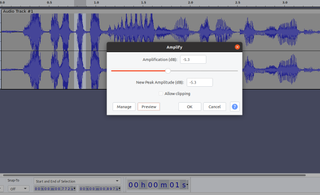
Now now now we have our potential guidelines of factors, let’s check out approaches to bettering our audio.
In our check out audio there was a small explosive click on on inside the audio that introduced on the VU meter to flash into the purple half and introduced on our headphones to briefly distort. You probably can usually see the aim inside the audio file and it’s best to use the zoom icons to zoom in on the difficulty.
It’s unlikely that we’re capable of cut back the distortion inside the audio at this stage nonetheless we’re capable of merely cut back the amplitude of this part of the waveform which signifies that although distorted for a second it doesn’t set off our audio system to pop and create discomfort for the listener.
1. Click on on barely to the left of the difficulty house and drag over the realm to the becoming so chances are you’ll highlight this small a part of clipped audio.
2. Click on on on the Outcomes drop down menu and select “Amplify”.
3. Reduce the amplification price each by typing a unfavourable price into the “Amplification (dB):” enter subject or by means of the usage of the slider. Try lowering the price to -1dB and click on on the “OK” button. The highlighted house of the waveform will cut back in prime.
4. Take heed to the model new mannequin and see if that has mounted the issue. Watch the VU meter and see if the difficulty nonetheless causes the output to clip displaying the purple line inside the meter. You probably can, actually, use administration and z to undo the adjustment or chances are you’ll return into the Amplify influence and make extra reductions or modifications.
Cleaning up an audible hiss
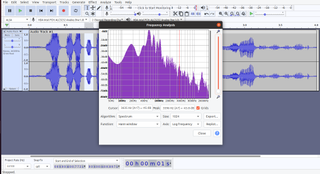
For our subsequent audio concern, let’s check out the standard extreme pitched hiss inside the background of an audio recording. This may increasingly very nicely be attributable to wind noise, or a really noisy AC unit. There are a few completely totally different approaches we’re capable of try to acquire this. A major technique to ponder is using a low cross filter or a notch filter to principally scale back the frequency house of the hiss out of the audio file. Nonetheless sooner than we do that, now we have to identify the place the issues are.
1. Select all the audio and from the Analyze drop down menu click on on Plot Spectrum. Throughout the Frequency Analysis window we’re capable of see all the frequencies which could be in our audio file. We don’t wish to grasp it completely for it to be useful nonetheless the first premise is the higher frequencies are to the becoming of the diagram and the left hand facet are the lower frequencies.
Most music has some audio knowledge in all frequency areas, nonetheless simpler recordings of a voice as an illustration might solely use specific parts of the range. This suggests we might be able to scale back out full parts of the frequency range with out affecting the objective audio inside the file. For a extreme pitched hiss concern you might also see a stand alone spike inside the increased frequencies the place the hiss is pitched, chances are you’ll then make a remark of the frequency house the hiss sits in by learning the X axis of the plotted spectrum. It will allow you to objective your filter to remove the hiss.
2. Make a note of which frequencies (x axis) are affected by hiss.
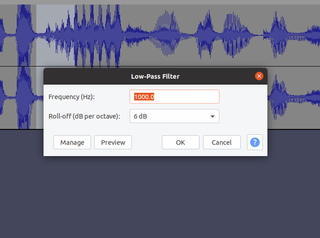
3. To remove a extreme pitched hiss, select all the audio file waveform and from the Influence drop down select Low Transfer Filter.
4. Throughout the Frequency enter self-discipline, enter in a price barely lower than frequency of the hiss then set Roll-off price by the use of the enter subject. If your hiss was at 1500 Hz chances are you’ll set the filter frequency to say 1400 Hz and tweak the roll-off price consistent with your requirements.
5. Take heed to the preview. It’s best to find a reduction in your hiss. If you happen to’re happy with the consequence, click on on OK to make use of. If not, return to step 4 and tweak the frequency / roll-off.
A notch filter is a filter that reduces all the frequencies in a notch kind inside the frequency response. That’s useful if in case you may have a recording the place possibly a hiss exists nonetheless using a lowpass filter might affect totally different parts of the audio. For example if you had a recording with numerous cymbals being carried out by a percussionist, eradicating a extreme pitch hiss might properly moreover affect the cymbal sound.
1. From Influence, select the Notch Filter.
2. Tweak the objective frequency (which might be the center of the notch) and click on on Preview.
3. Enhance / decrease the Q price for a wider / narrower notch. Click on on Preview to take heed to the audio.The outcomes can on a regular basis be undone so it’s value trying the filters repeatedly and replotting the frequency spectrum and listening to great tune your technique.
Lastly on filters, it’s best to use a extreme cross filter throughout which you select a frequency and each half beneath that frequency is lowered nonetheless one thing above it is unaffected. Extreme cross filters are generally an excellent reply for the rumble of a distant put together or totally different low frequency artifacts in a recording.
1. Click on on on Influence >> Extreme-Transfer Filter.
2. To remove a low pitched rumble, select the audio file waveform and from the Influence drop down select Extreme-Transfer Filter.
3. Throughout the Frequency enter self-discipline, enter in a price barely better than frequency of the rumble then set Roll-off price by the use of the enter subject. If your rumble was at 1000Hz chances are you’ll set the filter frequency to say 1100Hz and tweak the roll-off price consistent with your requirements.
4. Take heed to the preview. It’s best to find a reduction in your hiss. If you happen to’re happy with the consequence, click on on OK to make use of. If not, return to step 3 and tweak the frequency / roll-off.
Together with Noise Low cost
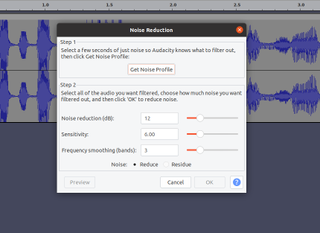
You may have a recording that has a additional sophisticated assortment of undesirable noises in it. For these troublesome circumstances, it could be useful to aim the “Noise Low cost” influence. This influence is very good if in case you may have some sections in your recording that solely comprise the undesirable noise and by no means the objective audio. In precise truth, when you’re recording inside the self-discipline and also you acknowledge a recording will comprise undesirable noise it’s very useful to create an excellent recording of what you don’t want!
1. Highlight a little bit of your audio file that solely accommodates the undesirable noise. It have to be over 0.05 of a second prolonged in a 44.1kHz WAV file however it certainly’s commonplace to pick a couple of seconds or additional.
2. Click on on on Outcomes >> Noise Low cost.
3. Click on on the Get Noise Profile button. The window will shut immediately nonetheless you can have mainly organize the influence with a sample of what you want to take away.
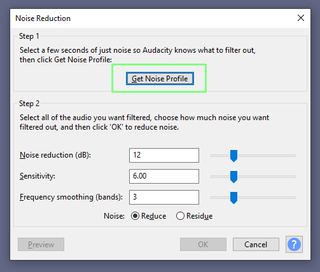
4. Select the realm of the file you want to apply the noise low cost influence to.
5. As quickly as as soon as extra, launch the Noise Low cost influence and tweak the values inside the “step 2” half. You probably can click on on the “preview” button inside the lower left hand nook of the dialogue subject to take heed to the have an effect on of your settings.
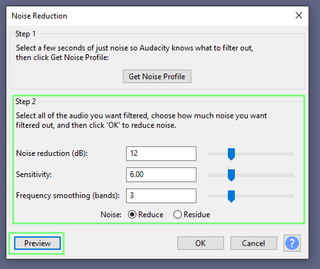
6. Click on on OK to make use of the noise low cost.
Using these approaches, you can have an excellent major toolset to wash up many different factors with audio info. If you end up utterly glad collectively along with your outcomes, use the File – Export to create your new, cleaned-up audio file.






